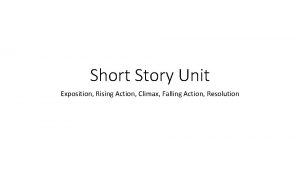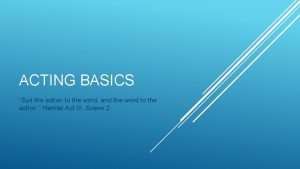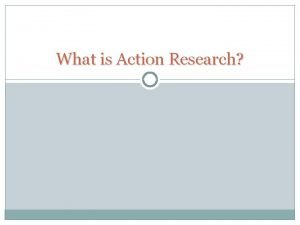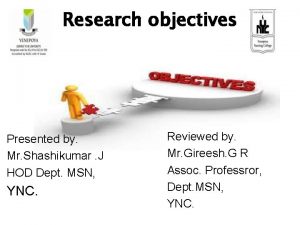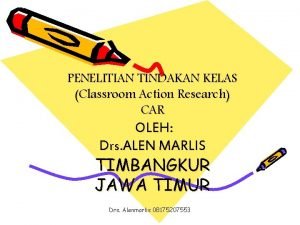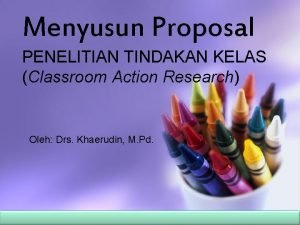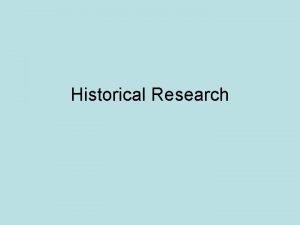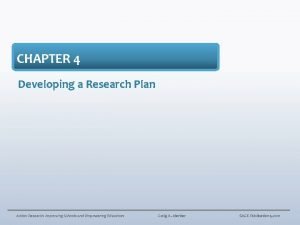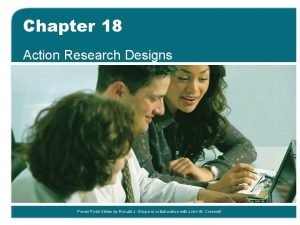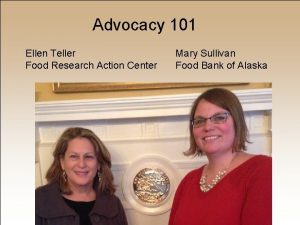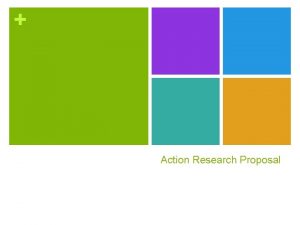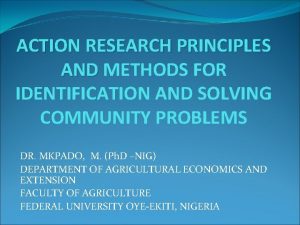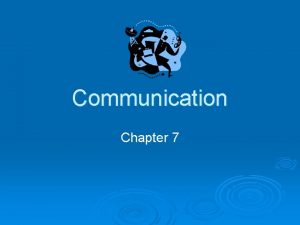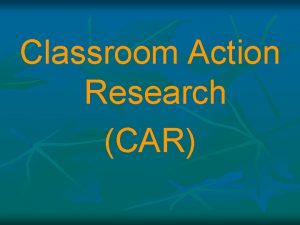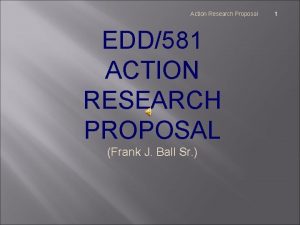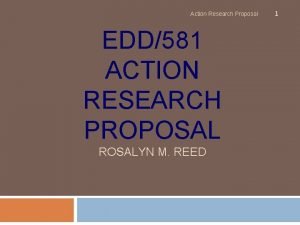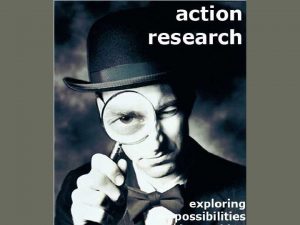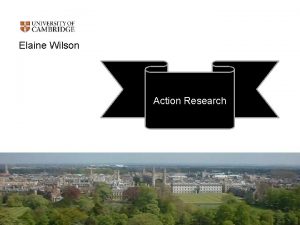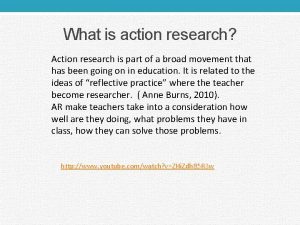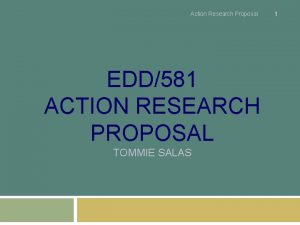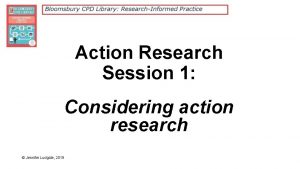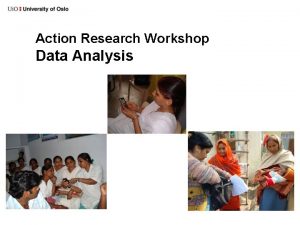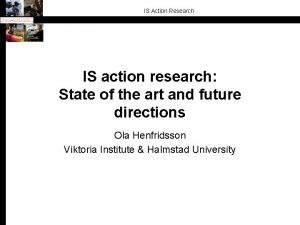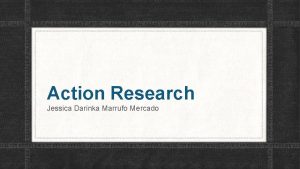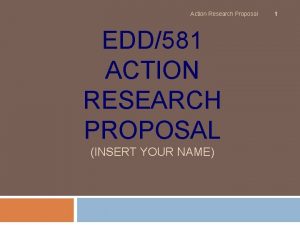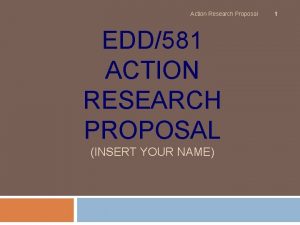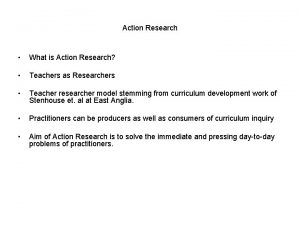What is Action Research Action Research It is


















- Slides: 18

What is Action Research?

Action Research “It is a part of a broad movement that has been going on in education generally for some time. Action Research involves taking a self-reflective, critical, and systematic approach to exploring your own teaching contexts. ” Burns (2010, p. 2)

Action Research �Something that characterizes AR, is its process in which one as a teacher identifies a problem in the class that can be improved. “AR improves a classroom dilemma by using a reflective research cycle of planning, acting, observing and reflecting. ” Burns (2010, p. 4)

Steps �According to Kemmis and Mc. Taggart (1988), who are the major authors in this field, AR typically involves four broad phases in a cycle of research: planning, action, observation, and reflection.

Planning �“In this phase it is identified a problem or issue and develop a plan of action in order to bring about improvements in a specific area of the research context. ” Burns (2010, p. 8) �It has to be considered: �What kind of investigation is possible within the realities and constrains of your teaching situation; and what potential improvements you think are possible.

Planning �This stage basically focuses on identifying a problem or and issue. It not necessarily needs to be a learner’s issue but a teacher’s issue. This is for check and gather as much data as possible for start the plan and improve specific details about the class, this for make it a better class.

Action �“The plan is a carefully considered one which involves some deliberate interventions into your teaching situation that you put into action over an agreed period of time. The interventions are ‘critically informed’ as you question your assumptions about the current situation and plan new and alternative ways of doing things. ” �Burns (2010, p. 8)

Action �In this stage, the teacher or the researcher, puts in practice different techniques in order to have a critical idea and check if the plan is functioning as it has been thought. �Ideally this stage should be criticized by another person, who ideally has to have certain level of knowledge. This for give a productive feedback to the researcher.

Observation “This phase involves you in observing systematically the effects of the action and documenting the context, actions and opinions of those involved. It is a data collection phase where you use ‘open-eyed’ and ‘open-minded’ tools to collect information about what is happening. ” Burns (2010, p. 8)

Observation �At this point there already had been some actions from part of the researcher. Therefore, it is time to recollect new information and analyze it. In this stage the effects of the action already done are checked for reflect about them in the next part.

Reflection At this point, the teacher reflect on, evaluate and describe the effects of the action in order to make sense of what has happened and to understand the issue that has been explored more clearly. (Adapted from Kemmis & Mc. Taggart, 1988, pp. 11 -14)

Reflection �In this last stage of AR, the teacher analyzed the data, and reflect about how good the recollection and critic of the information has been done. The teacher should be aware of what has been done and see if the issue was corrected or if there is something else that can be done.

Example #1 �Case study: Correcting Grammar �Place: Singapour �The researchers wanted to see whethere was a discrepancy between beliefs and classroom practices while assessing grammar in student written work (Farrell and Lee, 2003)

Example #1 �Planning: The teachers at the research made the following questions in order to focus in the issue they were investigating: 1. Should learner errors be corrected? 2. If so, when should learner errors be corrected? 3. Which learner errors should be corrected? 4. How should learner errors be corrected? 5. Who should correct learner errors?

Example #1 � “Responses from the teachers' interviews were transcribed analyzed to find out what the teachers claimed to do in the area of grammar correction in compositions and their underlying rationale for their perceived actions. The teachers' claimed practices were then verified through an analysis of their correction techniques as observed in the collected writing samples Recorded tapes and field notes from classroom observations were also used to confirm (or deny) the teachers' claimed practices in giving grammatical feedback. If data from the analysis of teachers' correction techniques in the writing samples and the classroom observations supported the responses made in the teacher interviews, this was regarded as an alignment between beliefs and practice. On the other hand, if data from the analysis of teachers' correction techniques in the writing samples and the classroom observations contradicted the responses in the teacher interviews, this was considered as a discrepancy between beliefs and practice. ” Thomas S. C. Farrel (2007)

Example #1 �Based on the results of the action step, there can be inferred different options. Depending on the results whether they were the ones that were expected or not, the observation and reflection depends of them. �For more information about this specific research: �http: //www 2. uah. es/master_tefl_alcala/pdf/arp_ar ticle. pdf

Example #2

References �http: //www 2. uah. es/master_tefl_alcala/pdf/arp_ar ticle. pdf �Thomas S. C. Farrel (2007) “Action Research” in Reflective Language Teaching: From Research to Practice, (pages 94 -106) Continuum. �Video Example #2: http: //www. youtube. com/watch? v=M 6 ABV 8 rg 28 k �Doing Action Research in English by Anne Burns (2010)(pages 2 -12)
 Plot sequence diagram
Plot sequence diagram Exposition plot
Exposition plot 4 stages of plot
4 stages of plot Exposition in a rose for emily
Exposition in a rose for emily Suit the action to the word the word to the action meaning
Suit the action to the word the word to the action meaning Action research vs case study
Action research vs case study General objective research sample
General objective research sample Contoh classroom action research
Contoh classroom action research Contoh judul penelitian action research
Contoh judul penelitian action research Historical research
Historical research Action research chapter 4
Action research chapter 4 Action research designs
Action research designs Ellen teller frac
Ellen teller frac Research proposal cover page apa
Research proposal cover page apa Action research project examples
Action research project examples Principles of action research
Principles of action research Action research cartoon
Action research cartoon Research action communication evaluation
Research action communication evaluation Contoh action research
Contoh action research



